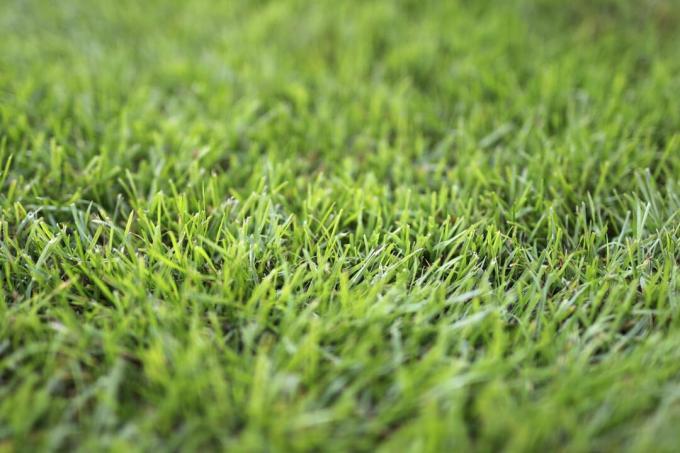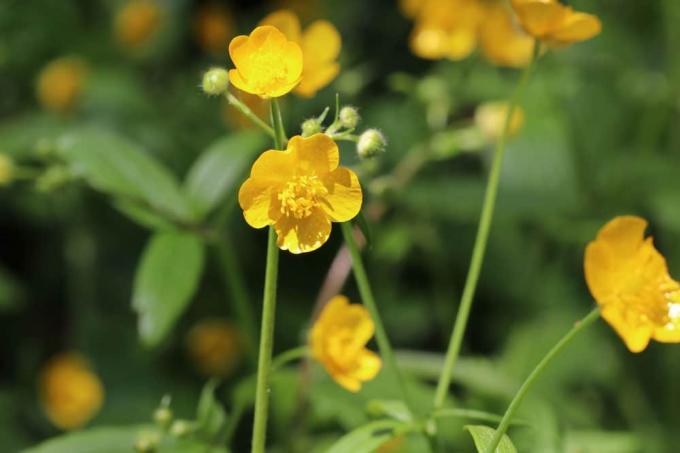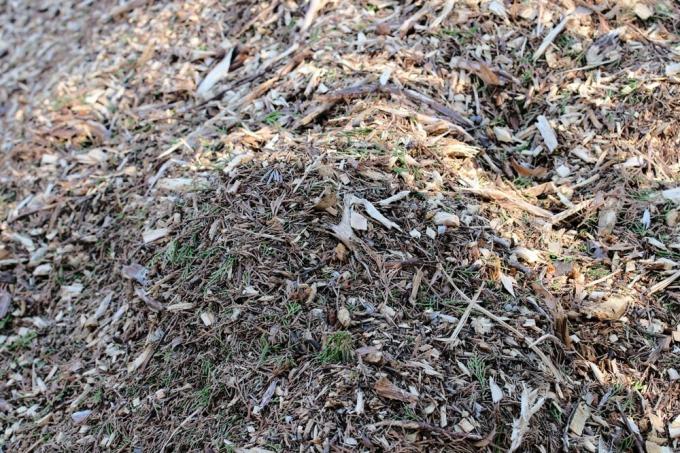

Table of contents
- recognize goutweed
- Fight early
- distribution
- Superficial distance
- remove roots
- smother tree drop
- Dispose of goutweed
- Bring in competing plants
- use herbicides
- Insert root barriers
- Giersch: Annoying but delicious
It starts with a single plant and can develop into a dense carpet at breakneck speed - the goutweed spreads in a very short time but sustainably and is difficult to remove again. A single piece of root is enough for the tree drop to sprout again. With the right means and measures, however, it can still be combated effectively.
recognize goutweed
The leaves of the tree drop are reminiscent of the leaves of the elder. The plants are usually up to 30 centimeters high, but can also reach sizes of 100 centimeters. They bloom white, the flowers are rather inconspicuous and have no bracts. Ground elder is best recognized by its spread. It grows very quickly and in dense carpets.
Fight early
Since tree drop spreads so quickly, it should be fought as early as possible. As soon as the first shoots appear in spring, quick action is required. This prevents weeds from spreading uncontrollably and damaging other plants.
distribution
Ground elder spreads both by seed and by root suckers. The groups of plants can therefore increase in size and spread throughout the garden due to the wind.
Superficial distance
A superficial removal is not a permanent solution, but it is helpful. This weakens the plant, albeit slightly, reducing growth and preventing seed formation. It makes sense to remove above-ground greenery in all accessible areas with a lawnmower, a lawn edger or, in the case of small accumulations, with scissors. Alternatively, it can also be demolished just above the ground.
remove roots
If root residues remain in the ground, the goutweed can develop new shoots up to a year later. It is therefore important to eliminate all rhizomes for complete removal.
We recommend the following steps for this:
- If necessary, water the soil a little so that the soil can be worked more easily.
- Cut and dig the soil to a depth of 30 centimeters.
- Loosen the individual pieces of soil and sieve very finely so that no pieces of root remain.
This measure should be done very thoroughly so as not to leave any rhizome remains in the soil. Otherwise the effort was in vain and the goutweed will only spread again in the dug soil.
smother tree drop

In some cases, it is not possible to dig up the ground while dripping the entire roots of the tree to be removed, for example on tree discs, around shrubs and in dense growth on others Plant.
In these circumstances it can make sense to smother the goutweed. This can be done with the following steps:
- Chop off, cut off or mow the goutweed. The stems should be trimmed as close to the ground as possible.
- Lay out impermeable foil, thick cardboard or garden fleece. Gaps and holes should be avoided.
- Cover the foil thickly with gravel or bark mulch. It should be at least five to ten centimetres.
- Carry out regular checks. Even individual shoots of the tree drop should be removed immediately. Since it grows very quickly from spring to autumn, checks should be carried out weekly.
- keep patience! Ground elder is very persistent and can sprout again after many months to a year if given the opportunity. The cover should therefore remain on the tree disc for at least one to two years in order to kill the weeds effectively and sustainably.
Dispose of goutweed
If the tree drop ends up on the compost, it will most likely only sprout again and distribute seeds. It is therefore better to dispose of it with organic waste or household waste. If the plants have already formed their caraway-like seeds, special care should be taken when removing and disposing of them. In these cases it is advisable to burn the plants and seeds. Alternatively, the seed bearing shoots can be carefully cut off and placed directly in a bag or pouch. This reduces the risk of seeds dispersing around the area. Even with such thorough removal and disposal, it is still possible that individual seeds have already been spread by wind, animals or gardening. It is therefore important to continue to carry out regular checks.
Tip:
The tree drop can also be used as a fertilizer if a plant manure is made from it.
Bring in competing plants
Strongly consuming and fast-growing plants such as potatoes, aubergines and courgettes compete with ground elder for water, nutrients and space. This can slow down weed growth. To prepare the soil and as a simple way of combating it, we recommend cultivating heavy feeders with dense foliage. A nice side effect of this variant is the subsequent harvest.
use herbicides
The use of herbicides should be a last resort as it will also affect useful or ornamental plants and pollute the soil. Therefore, care should be taken when choosing a gentle agent. In addition, herbicides should not be used near other plants.
Insert root barriers
Using root barriers and lawn curbs around trees and shrubs, beds and borders makes it easier to control weeds in general and ground elder in particular. The spread via root suckers is reduced. However, seeds can still be distributed in the environment. They are therefore only useful if the tree drop is kept as short as possible and flowers are removed immediately.
Giersch: Annoying but delicious
Before goutweed was considered a nuisance weed, it was used as a spicy herb, in leafy vegetables and in salads, and also used in herbal medicine. The plants do not have to be disposed of, but can also end up on the plate.
 garden editorial
garden editorial I write about everything that interests me in my garden.
Learn more about weed

remove moss | 7 biological moss removers
If you want to remove moss, you don't have to use chemicals. Because weeds can also be effectively combated with numerous home remedies!

Weed killer for the lawn: when can you start mowing?
Weed killers are one of the most important ways to rid your lawn of weeds. So that there are no problems with use, a few points must be observed that guarantee the success of the funds after use.

17 Identify lawn weeds | Recognizing lawn weeds overview
Whether they are called lawn weeds, weeds or weeds, no hobby gardener likes them in domestic ornamental and useful lawns. In order to be able to decide quickly and easily on the need and type of elimination, our list helps to identify and evaluate the troublemakers.

Bark mulch against weeds: how does mulch help to protect against weeds?
Mulch is becoming increasingly popular in the garden. This includes above all the bark mulch, which is made from waste from the wood industry. Bark mulch can be used for a variety of purposes, including weed suppression. How to do this is explained in this guide.

Hydrochloric acid against weeds, bamboo and ivy | Are acids allowed?
Weeds are annoying. Removing it is one of the most tedious and unpleasant jobs in the garden. Of course, one thinks about a radical solution to the problem. However, using hydrochloric acid against weeds is not a good idea and is not permitted.

Where are weed killers banned? That's what the law says...
Weed killers are practical - but not allowed everywhere. Where are they banned and what does the law say about them? We inform hobby gardeners about the most important rules for plant protection and legal, natural alternatives for weed killing in their own garden.
